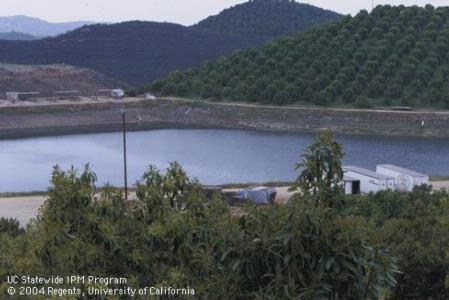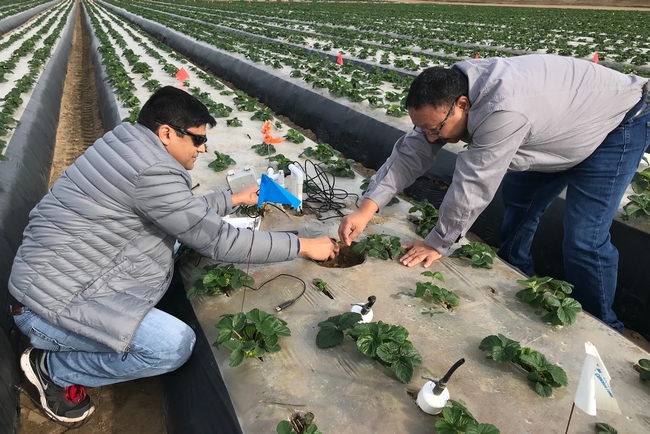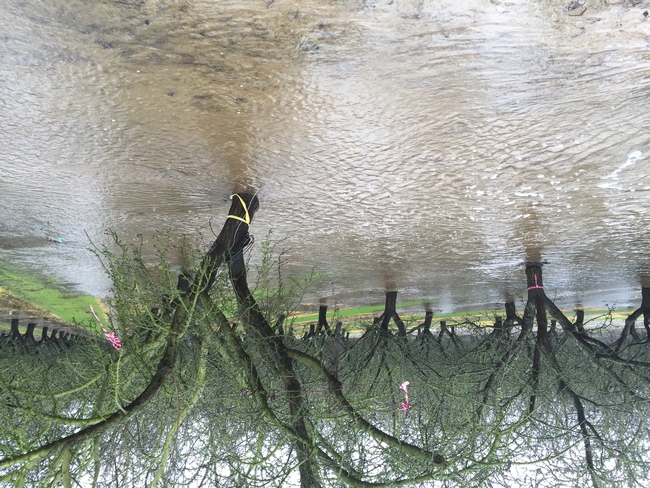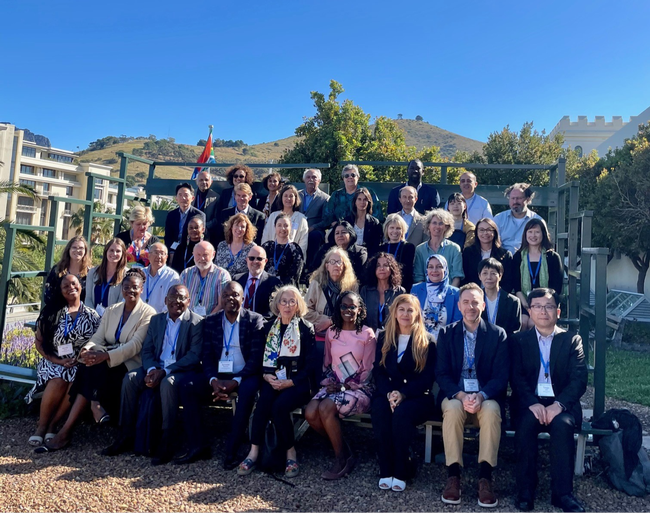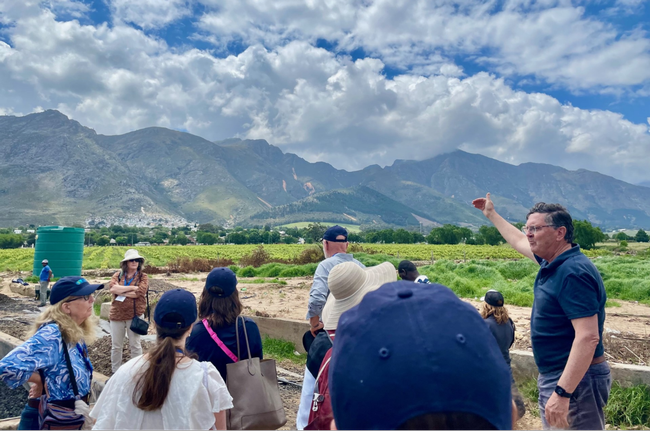Posts Tagged: water-use
Sewage to Sustenance
- UC Riverside, Senior Public Information Officer
Plant materials that would otherwise become trash may be the key to solving two big problems: diminishing freshwater supplies for farms and diminishing effectiveness of antibiotics.
On average, agriculture accounts for 70% of global freshwater use. In California, which produces nearly half of all U.S.-grown fruits, nuts, and vegetables, that number rises to 80%.
The United Nations estimates food production will need to double by 2050. However, water supplies will not increase accordingly. Instead, due to climate change and drought, water resources are quickly shrinking.
One solution to the increasing need for farm water is to use treated municipal wastewater. There are roughly 16,000 wastewater treatment plants in the U.S., each of them capable of processing up to 10 million gallons every day.
“It's a huge amount of processed water that's mostly clean and can be used again, but there's a problem,” said Ananda Bhattacharjee, assistant project scientist at the U.S. Department of Agriculture's Salinity Laboratory, based at UC Riverside.
“This water can contain chemicals of emerging concern, like antibiotics, that are difficult to detect and treat without advanced and expensive instrumentation,” he said. “These instruments also require trained laboratory personnel to operate and maintain.”
Once exposed to the antibiotics in the water supply, soil bacteria immediately start developing resistance to the drugs because they want to survive. “Bacteria are amazing biological sensors,” he said. As the bacteria develop resistance, antibiotics stop working.
Once crops are irrigated with contaminated reclaimed water, plants that get harvested and come to our dinner tables may contain residual antibiotics, resistance genes, and resistant bacteria.
To correct this issue, Bhattacharjee is leading a new, $1 million project testing a low-cost technology to make the reclaimed water safer for agricultural re-use. Funded by the USDA's Agriculture and Food Research Initiative, the project will test how effectively biochar made from various types of discarded plant materials can “polish” the water.
Biochar is a charcoal-like substance made by burning organic material. Burning any organic matter, even wood chips, in limited-oxygen environments retains the mass of the burned substance. The remaining, charred substance is highly absorbent.
“It's like activated charcoal used in HEPA filters and HVAC systems. Biochar works on the same principal; it adsorbs chemicals present in reclaimed water and allows only clean water to pass through,” Bhattacharjee said.
Based on this principle, Daniel Ashworth, a soil scientist at the Salinity Laboratory, first built a bench-scale filtration system with biochar for the removal of antibiotics in synthetic wastewater. The results were very promising, with antibiotics removal efficiency of up to 98%.
“Encouraged by Dr. Ashworth's experiments, we will be designing the larger-scale biochar-based polishing systems for removing residual antibiotics in reclaimed water,” Bhattacharjee said.
Using biochar polishers could potentially remove the need to detect the antibiotics in reclaimed water, assisting treatment plants that do not have advanced detection or treatment technologies, and cannot afford them.
Affordability is one of the best features of the biochar system. “As engineers, we try to keep it simple. If we can build something for a dime, we don't want to have to spend a dollar,” Bhattacharjee said.
For this project, scientists from UC Riverside, the U.S. Department of Agriculture, US Salinity Laboratory, and the University of California's Agriculture and Natural Resources are teaming up to test biochar made from multiple kinds of plant materials left over from agricultural field production.
To start, they'll collect treated sewage sludge and plant materials such as pistachio shells and date palm leaves which would otherwise be thrown away. These materials will be turned into biochar for designing filtration systems that reclaimed water can pass through.
Ultimately, the team would like to develop a database of different, inexpensive biochar materials that can all be used for removing harmful compounds from reclaimed water for agricultural reuse, especially crop irrigation.
If the costs remain low and effectiveness remains high, the research team hopes growers will install biochar-based reclaimed water polishing systems on their farms. “That is the major goal of the project, taking this from bench scale to full field scale,” Bhattacharjee said.
Right now, the whole ecology of fields is changing due to residual antibiotics in irrigation systems. The reclaimed water gets into the soil, earthworms feed on organic matter in the soil, and they develop antibiotic resistance in their guts. Then they may release this resistance through their feces, making additional changes to soil microflora, which keeps the cycle of resistance going.
“We are slowly spiking our own agricultural fields with this resistance,” Bhattacharjee said. “Demonstrating this issue was our first project, Bacteria Wars: episode one. Now we have a technique to remove the antibiotics and resistant bacteria, reducing the antimicrobial resistance spread in agriculture. This is our episode two: Researchers Strike Back.”
subscribe to the Topics in Subtropics blog: https://ucanr.edu/blogs/blogcore/subscribe.cfm
Water risks to agriculture: Too little and too much
Water is among the most precious resources on the planet. Some areas don't get enough; some get too much. And climate change is driving both of those circumstances to ever-growing extremes.
Two UC Merced experts in civil and environmental engineering took part in a recent report by the Environmental Defense Fund examining the issue and potential solutions. Associate Professor of Extension Tapan Pathak and Professor Josué Medellín-Azuara co-authored the report, "Scarcity and Excess: Tackling Water-Related Risks to Agriculture in the United States," and wrote the section pertaining to California.
In addition to climate change, disruptive human interventions such as groundwater over-extraction, sprawling drainage networks and misaligned governance are driving up water-related agricultural costs, particularly in midwestern and western states, the researchers found.
The problem is magnified in California, which hosts the largest and the most diverse agricultural landscape in the U.S., Pathak and Medellín-Azuara wrote, with gross revenues from farms and ranches exceeding $50 billion.
"Due to the favorable Mediterranean climate, unique regional microclimate zones, a highly engineered and developed water supply system, and a close connection between producers and research and cooperative extension institutions, California's agricultural abundance includes more than 400 commodities, some of which are produced nowhere else in the nation," the UC Merced researchers wrote.
But the state's varying climate and water needs pose a challenge. Though most of the precipitation falls in the northern part of California, the southern two-thirds of the state account for 85% of its water demand. And all of those crops must be watered in the summer, when there is little, if any, rainfall.
Some of the water comes from snowpack developed through winter storms and stored in reservoirs as it melts. Much of it comes from the Colorado River.
"Substantially less water is captured and stored during periods of drought, imperiling California's water supply and putting agricultural water needs at risk," Pathak and Medellín-Azuara wrote.
Climate change, with increasing periods of drought between excessively wet winters, magnifies that risk.
"Further, the rate of increases in the minimum temperatures in the Sierra Nevada is almost three-fold faster than maximum temperatures, resulting in potential decrease in the snowpack, earlier snowmelt, and more water in liquid form as opposed to snow," the researchers wrote. "According to the California Department of Water Resources, by 2100, the Sierra Nevada snowpack is projected to experience a 48% to 65% decline from the historical average."
Climate change is also expected to affect the availability of water from the Colorado River.
Climate extremes such as heat waves, drought and flooding - giving rises to increased weeds, pests and disease - are already significantly impacting agriculture and the broader economy, Pathak and Medellín-Azuara wrote.
The state's drought from 2012 to 2016 led to about 540,000 acres of fallow farmland in 2015, costing the state's economy $2.7 billion in gross revenue and 21,000 jobs. With the lack of precipitation, farmers increasingly pumped groundwater to irrigate crops, depleting those resources.
The report goes on to recommend policies, programs and tools be developed for agricultural resilience, including:
- Changing land use and crop management practices to support a transition to an agriculture footprint that can be sustained by the available water supplies.
- Increasing farmer and water manager access to important data and innovative technological tools to support their efforts.
- Reimagining built infrastructure and better using natural infrastructure so regions are better equipped to handle weather extremes.
- Developing policy and funding mechanisms to support mitigation and adaptation to water-related risks, avoid maladaptation and ensure food and water security.
"California's innovative agriculture needs to rapidly adapt to more volatile water availability, climate-driven higher water demands, and regulation protecting groundwater reserves, communities and ecosystems," Medellín-Azuara said. "The early adoption of more sustainable practices in agriculture will likely pay off dividends both in the short and long terms."
Added Pathak, "California faces significant challenges related to climate change, but it also presents opportunities for innovations, collaborations and sustained growth. To make agriculture resilient to climate risks, we need to engage in holistic solutions that integrates environmental, social, economic and policy considerations."
UCCE Mendocino & Lake Counties Contact Information and Interest Signup Survey
It has been many years since UC Cooperative Extension aka Farm Advisors have done an educational interest survey and updated our client contact database. There have been a lot of changes in our staff and many new farmers and ranchers have come into our counties so the time is right to update old information and let others, that are not familiar with our programs, join our clientele/supporter contact list.
We've also decided to go to a more modern program for informing the public and our supporters about the educational and research programs we offer in Mendocino and Lake Counties. The name of the program we'll be using is called Constant Contact.
We've learned from the Covid restrictions how to offer some of our educational programs through webinars, zoom conferences and social media. We realize not everyone likes some of these formats, or have poor Internet connection speeds. We are offering our traditional public workshops and field days again. We want to make sure you get our information through your preferred delivery methods. For some of you who may not be familiar with our programs, a few questions below will help you to know the specific areas we can provide information and research on and will insure you only get what you're interested in.
Thanks in advance for taking the time to fill out our survey. Personal information provided to us is confidential and will never be shared with anyone. If, after filling out our survey and receiving information from us, you no longer want to be contacted by us you may at any time asked to be removed from our contact database. All participants who submit a survey are eligible to enter a random drawing to win one of three Amazon $100 e-gift cards. We will be drawing for winners from everyone who opted in for the drawing and complete our survey.
The survey is on-line at: https://surveys.ucanr.edu/survey.cfm?surveynumber=7082
Please also share the link with others who would be interested in our programs. Thanks!!!
Groundwater Help
The Department of Water Resources (DWR) developed the Underrepresented Community Technical Assistance Program (URC TA Program) after learning that some Groundwater Sustainability Agencies (GSAs) have not been able to address the needs, risks, and vulnerabilities with the implementation of the Sustainable Groundwater Management Act (SGMA) to a sufficient extent within their Groundwater Sustainability Plan(s) (GSPs) or Alternative to a GSP (Alternative). DWR recognizes the need for addition assistance and, thus, implemented the URC TA Program to address this need and is the sole mission of the URC TA Program.
The mission of the URC TA Program is to determine the needs, risks, and vulnerabilities with the implementation of the Sustainable Groundwater Management Act (SGMA) for URCs in medium and high priority basins, including critically overdrafted (COD) basins.
DWR retained the services of a consultant group in 2021 to begin the URC TA Program utilizing Proposition 68 funds.
DWR is assisting Tribes and other URCs identified in the heat Maps found below. The URC TA Program will provide onsite engineering, geologic, hydrologic, and other technical services to the communities based upon a ranking of water systems. The types of services provided include, but are not limited to:
- Groundwater level monitoring
- Aquifer testing to determine long-term yield and supply
- Identifying Groundwater Dependent Ecosystems (GDEs)
- Analyze well interference
- Identifying additional water supply
- Analyze existing well condition using downhole video log
- Rehabilitation of water storage tank
- Long-term water supply and demand analysis
- Analyze and help to facilitate water transfers
In addition, DWR hired a nongovernmental agency (NGO) in 2022, using General Funds provided by the Budget Act of 2021, to expand upon the URC TA Program. The additional services DWR is providing through this agreement will:
- Create a template for local domestic well impact mitigation to develop plans for drinking water well protection. Share the data with three (3) local GSAs for the GSAs to develop a mitigation program. Provide ongoing community engagement by attending the three GSAs board meetings or committee meetings to submit the community's needs, risks, and vulnerabilities of URCs in their basin to amend GSPs or Alternatives.
- Analyze and provide feedback on proposed policies and programs by submitting written feedback to the three identified GSAs a minimum of three times a year for two years.
- Revise the existing Communication and Engagement Plan (CEP), if needed.
- Develop educational and outreach materials, if needed.
- Work with the three GSAs and community leaders previously identified to support and implement drinking water and wastewater service projects to help reduce vulnerabilities to groundwater contamination by providing written feedback to those three GSAs.
- Develop a financial strategy plan for the three GSAs to identify long-term strategies for addressing impacts of depleting groundwater supplies, drought, and climate change.
- Identify two common groundwater dependent vegetation species and develop groundwater thresholds that would lead to irreversible transition from a stable state of ecosystem structure. Develop a technical memo with the results of the study and datasets to support incorporation of results into GSP updates.
DWR was provided an additional $9.5 million in General Funds to expand the definition of a URC to include small and socially disadvantaged farmers and to provide technical assistance to the small farmers located within medium and high priority basins and COD basins. Additional information will be provided in early 2023.
Local entities will be able to request services through the SGM_TA@water.ca.gov email address managed by SGM Grant Program Team.
The Technical Assistance Program identifies communities throughout California with water supply challenges such as dry groundwater wells, water shortages, or poor water quality. Using publicly available data, DWR prepared a community identification tool (CIT) that collects relevant information for each census block within the State of California. The data includes, but is not limited to, Median Household Income (MHI), threats to groundwater, access to drinking water, and surface water quality. This information is used to quantify areas of greatest water-related need and applied statewide for Tribal Communities and within hydrologic regions including Northern California, Central California, and California's Central Coast for other Underrepresented Communities. For more information on the Underrepresented Community Prioritization Tool methodology, please refer to the Technical Memorandum Summary.
https://water.ca.gov/Work-With-Us/Grants-And-Loans/Sustainable-Groundwater/Underrepresented-Communities-Grants
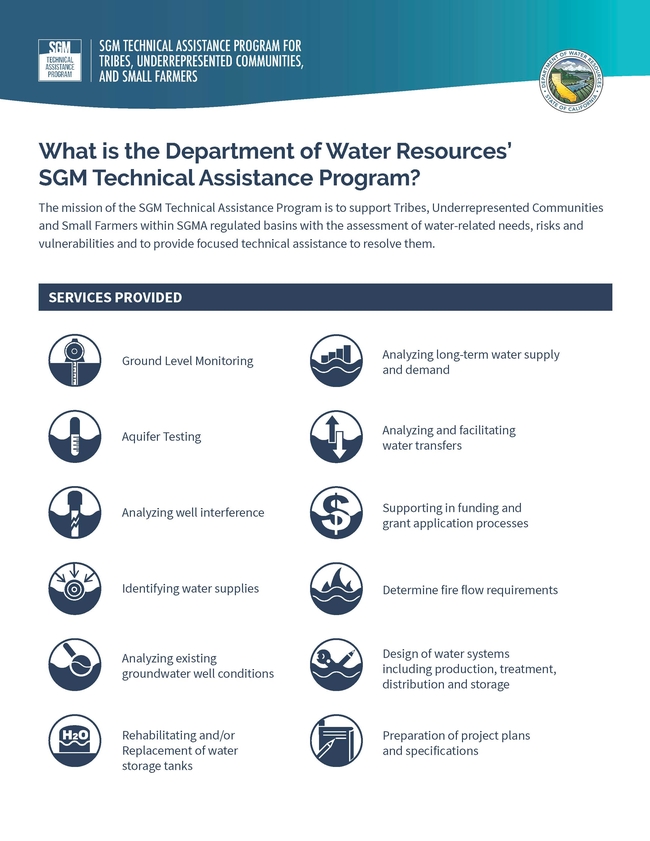
DWR SGM TA Services
International water scholars convene in South Africa
Water scholars from 18 countries gathered in South Africa for the 11th biennial Rosenberg Forum on International Water Policy. Hosted at the University of Cape Town's (UCT) Water and Production Economics (WPE) research unit, this year's forum included the most diverse group to date, in terms of discipline, geography and early-career professionals. The week-long event, Oct. 23-27, addressed water quantity and quality management, economic production and welfare implications in the Global South.
Glenda Humiston, advisory committee member and University of California vice president of agriculture and natural resources, and Soroosh Sorooshian, forum chair, advisory committee member and distinguished professor of the departments of Civil and Environmental Engineering and Earth System Science at UC Irvine played key roles in planning and facilitating this year's forum.
Innovative approaches to water management – lessons from the Western Cape
This year's Rosenberg Forum kicked off with a day-long tour to observe public water system infrastructure and research sites in the Western Cape. These activities were arranged by Djiby Thiam, professor of economics and director of Water and Production Economics Unit at the University of Cape Town.
“Given the growing population and economic development that characterize countries in the Global South, water demand is expected to grow, putting more pressure on the limited natural resources. And this may affect social welfare,” Thiam noted.
During the tour, forum attendees discussed ongoing challenges and innovations in storm water management, blue-green infrastructure, aquifer recharge andwastewater treatment. Tour stops included an urban watercatchment site, the Berg River Dam, and a working farm that uses treatedwastewater for irrigation, among others.
Diverse perspectives to address water challenges
Wednesday and Thursday's sessions included presentations and panels addressing a range of topics related to challenges and opportunities to increase efficient and equitable water use in the Global South.
Wednesday's sessions emphasized the need to improve digital technology to address climate change, gender-inclusive approaches to climate-smart agriculture, wastewater reuse for irrigated agriculture, and the importance of building institutional capacity for policy changes.
According to Caroline Gelderblom of the World Wildlife Fund International in South Africa, “there is increasing awareness that there is a need to build cross-sectoral extension efforts to improve both national and international water resource strategies.”
Extension strategies that address multiple welfare challenges are quickly being adopted across the globe, but further integration is needed, particularly in water-scarce regions.
Thursday's sessions explored issues related to water pricing, collective management of surface and groundwater water resources and new approaches to address water scarcity.
Unpacking water management complexities in the global south
Friday's discussions included a technical workshop where scholars and practitioners presented research on the complexities associated with water in agriculture, urban and mining sectors, climate-induced risks, and policy interventions.
Organized by Thiam; Ariel Dinar, distinguished professor of environmental economics and policy at the UC Riverside School of Public Policy; and Christina Babbit, water stewardship senior manager of enterprise sustainability at Starbucks, the final day of the forum allowed scientists to present rigorous academic research on the policy interventions that are needed to address critical social, economic and environmental challenges in water management.
The technical workshop allowed scholars to test research methodologies that influence policymaking and, according to Thiam, are rigorous enough to be shared with an academic audience.
Technical manuscripts from this workshop will be published in a special issue of the Journal of Applied Economic Perspective and Policy.
History of the Rosenberg Forum
In 1996, the forum was established as an endowment gift from Bank of America's former chairman and CEO Richard Rosenberg. His vision was to bring together international scientists and policymakers to address global water issues through information-sharing, dialogue and data-driven decision-making.
Biennially, the forum convenes experts from around the world to identify approaches to reduce conflict in the management of water resources. The Rosenberg Forum is a program of the University of California Agriculture and Natural Resources' California Institute for Water Resources.

